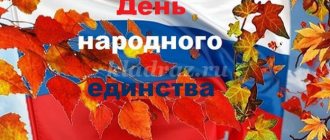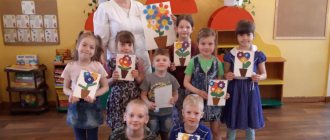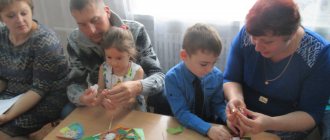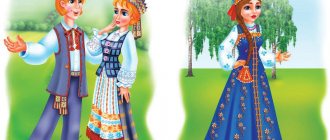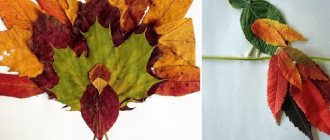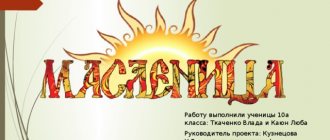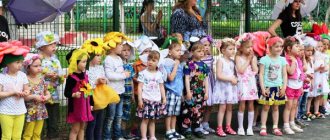Conversation about space (senior group)
author: Averinskaya Irina Sergeevna
teacher-speech therapist MADOU kindergarten “Zvezdochka”
Conversation about space (senior group)
Conversation on the topic: “Space” (senior group)
using the presentation "COSMOS"
Goals:
Educational: to form children’s understanding of planet Earth, to introduce the first cosmonaut Yu. A. Gagarin.
Developmental: expand children’s ideas about the profession of an astronaut pilot, stimulate the development of speech, memory, thinking, develop imagination and fantasy.
Educational: to instill respect for the profession of an astronaut, to teach respect for planet Earth.
Vocabulary: Earth, sky, star, planet, sun, moon, space, rocket, astronaut.
Speech therapist:
Please tell me, do you know what holiday is celebrated in our country on April 12?
Speech therapist:
Today we will find out what kind of holiday this is!
II slide “What is space?”
Speech therapist:
Very often, people, looking at the sky, ask themselves the question: “What is there? Behind the cloud?" - Space. What is SPACE? - this is the space that surrounds our planet Earth, in which stars and planets move...
III slide
Speech therapist:
People have always wanted to know, is there life on other planets? And if there is, who lives there? But to find out, you need to fly to the planets. But how to do that?
IV slide
Speech therapist:
Almost 100 years ago, a simple teacher Konstantin Eduardovich Tsiolkovsky lived in the city of Kaluga. He loved to watch the stars through a telescope and studied them. There are many different planets and stars in outer space. And he decided to construct an aircraft that could fly to some planet. Unfortunately, he did not have the opportunity to build it.
And only many, many years later, a group of scientists made the first space satellite.
V slide
Speech therapist:
but the first to fly into outer space were not people, but animals, two husky dogs: Belka and Strelka
(consider)
VI slide
Speech therapist:
They became the first living creatures from planet Earth to stay in orbit for more than a day and return home safely.
VII slide
Speech therapist:
The first cosmonaut of the Earth was... Yuri Alekseevich Gagarin. On April 12, 1961, on the Vostok spacecraft, he went into space for the first time. Since then, this day has been celebrated in our country as Cosmonautics Day.
Speech therapist:
So what holiday is celebrated in our country on April 12?
Children:
Cosmonautics Day.
Speech therapist:
Well done! Aviation and Cosmonautics Day. Repeat again to remember.
Children repeat:
On April 12, our country celebrates Aviation and Cosmonautics Day.
Speech therapist:
And why on this day – April 12?
Speech therapist:
On April 12, our cosmonaut flew into space for the first time.
VIII slide
Speech therapist:
Do you remember the name of the first cosmonaut?
Children:
Yuri Gagarin
Speech therapist:
Well done!
Phys. minute "Cosmonauts"
(
coordination of speech with movements
)
Speech therapist:
Let's play, fly on a rocket
| I want to become an astronaut, I’ll fly on a rocket, | Bring your arms up above your head. |
| I will wrap it around the earth | Run in a circle - turn in the opposite direction |
| I'll land far away from everyone. | Run around the room, sit down. |
IX slide
Speech therapist:
What do you think an astronaut should be like?
Children:
strong, courageous, resilient, resourceful, hardworking, intelligent, quick-witted, self-possessed, etc.
X slide
Speech therapist:
You correctly said that an astronaut must be strong and resilient, because the suit he puts on during the flight weighs almost 100 kilograms. Maybe you know what it's called?
Yes, it's called SUITSUIT.
Consider the costume of the first cosmonaut and a modern spacesuit (on the slide)
Explain that the astronaut needs a spacesuit for breathing (oxygen supply), maintaining the required body temperature, and radio communications.
XI slide
Speech therapist:
And this is how astronauts from space see our planet.
And they call it “Blue Planet”. Think - why? (brown color is mountains, earth; green is forests, and blue is water - seas, oceans... Most of the planet Earth is occupied by water - that’s why there is so much blue color - that’s why they call it BLUE)
Speech therapist:
guess the
riddle riddle:
A man is sitting in a rocket.
He boldly flies into the sky, and towards us in his spacesuit
He's looking from space.
XII slide
Speech therapist:
Let's divide the word COSMONAUT into syllables
Children:
(
divided into syllables)
– clapping hands, chin control
(child’s choice)
Speech therapist: (syllable analysis)
— What is the 1st syllable?
- 2nd syllable?
- 3rd syllable?
— How many syllables are there in the word COSMONAUT?
Similarly, divide into syllables and do a syllabic analysis of the words: SPACE, ROCKET, SATELLITE, LANDING
XIII slide
Speech therapist:
I will read the poem “Rocket”, and in the evening, to please mom and dad, we will learn it.
Conversation about space (senior group)
Cosmonautics Day. Conversation in kindergarten. Senior group
Cosmonautics Day in kindergarten.
Author: Bondarenko Ekaterina Nikolaevna, teacher. Place of work: MBU kindergarten No. 49 “Merry notes”, Tolyatti
The theme of space is always interesting for children. Therefore, on April 12, Cosmonautics Day, educators hold holidays, competitions, and educational classes on the topic: Cosmonautics. We invite you to conduct an educational lesson for preschoolers in the form of a thematic conversation.
Thematic conversation for Cosmonautics Day “Man rose to the sky”
Objectives: 1. Generalize and expand children’s knowledge about the Universe. 2. Give an idea about the first cosmonaut, about the significance of Yuri Alekseevich Gagarin’s first flight into space, about the inventor of the space rocket, about the Cosmonautics Day holiday. 3. Form cognitive interests; the concept of oneself as an inhabitant of planet Earth. 4. Activate the vocabulary: sky, stars, planets, satellites, astronaut, Sun, Earth, Moon. 5. Enrich the vocabulary: Galaxy, Universe, Solar system, Mercury, Venus, Mars, Jupiter, Saturn, Uranus, Pluto, weightlessness, orbit, meteorite, spacesuit, lunar rover, orbital station. 6. Develop experimental activities and experimentation. 7. Foster respect and a sense of pride for the achievements of your people, based on specific historical facts. Equipment: paintings depicting the starry sky, outer space, portraits of K. E. Tsiolkovsky, S. P. Korolev and Yu. A. Gagarin, photographs of rocket launches from the Baikonur cosmodrome, photo albums about space explorers. Preliminary work: conversations about stars, planets, space and astronauts. Progress: Educator: - Many centuries passed before humanity found a way to overcome gravity and rise into outer space. Guys, remember the fairy tales and legends. What fairy-tale heroes didn't fly on! (On bats and eagles, on flying carpets and wizards’ beards, on the Little Humpbacked Horse and magic arrows...). Just a few centuries ago, no one could have imagined that the most convenient “transport” for moving around was a rocket. Mini-powder rockets have long been used to create fireworks or send signals in military affairs. In Russia, in the middle of the last century, artillery general K.I. Konstantinov gave the rocket its combat function. Its missiles could cover a distance of up to three kilometers.
The first who saw in a rocket a projectile capable of carrying earthlings into interplanetary space was the great Russian scientist K. E. Tsiolkovsky. He said this about this: “The earth is our cradle, but you cannot live forever in a cradle.” The rocket does not need air, which means it can fly in the void, in space, and reach enormous speed there. It took a lot of work to create the first rocket. It was built by Russian scientists, workers, and engineers. It was in our country that the first artificial Earth satellite was launched. Guys, do you know who the first astronaut was? What do you know about this person? When was the first space flight made? (The adult listens to the children’s answers and asks clarifying questions).
Yuri Alekseevich Gagarin first flew into space on the Vostok-1 spacecraft. His call sign “Cedar” was recognized by all the inhabitants of our planet. Although Gagarin spent only 108 minutes in space, making only one revolution around the Earth, this was only the beginning - the beginning of human exploration of outer space. Half a century has passed since then, but during this time cosmonauts from many countries, both men and women, have been in space. The first human flight into space opened the era of international space stations, the desire to explore the planets closest to Earth - Mars and Venus. Listen to how the poet Alexander Tvardovsky speaks about the day of the first flight into space in his poems. Ah, this day - the twelfth of April, How it swept through people's hearts. It seemed that the world had involuntarily become kinder, shocked by its victory. What kind of universal music he thundered, That holiday, in the motley flame of banners When the unknown son of the land of Smolensk. Was adopted by the Earth-planet. An inhabitant of the Earth, this heroic fellow, In his space vessel In a circular, forever unprecedented manner, In the depths of the sky, he waved above it... Dynamic pause “Cosmonauts” (Demonstration of physical exercises, involving children in their actions). To become an astronaut, children. From a very young age, you need to accustom yourself to order: Make your bed, do physical exercises. Let's stand straight, shoulders wider, Hands up, stay straight. From such exercises you will become stronger and stronger. Today, space flights have become completely commonplace for us, the inhabitants of the Earth. It is believed that the exploration of other planets is not far off. But the beginning of this was laid by our Russian cosmonaut. American astronaut Neil Armstrong, the first earthling to walk on the Moon, said this about Yuri Gagarin’s flight: “He called us all into space.” Show and tell about the planets.
We recommend watching:
Poems and ditties for Cosmonautics Day for kindergarten Scenario of thematic leisure time for Cosmonautics Day in kindergarten Summary of educational activities in the middle group on the topic “Oh, if only I were an astronaut” Design of a preschool educational institution for Cosmonautics Day
Similar articles:
Abstract of GCD in the senior group on the topic: Space
Scenario of thematic entertainment in the middle group for Cosmonautics Day
Sports game competition in the senior group for Cosmonautics Day
Game scenario - quizzes in the preparatory group on the topic "Space"
Summary of GCD in the preparatory group “Space Travel”
Journey into space
Summary of the GCD dedicated to Cosmonautics Day for children of senior preschool age
On April 12, our country celebrates Cosmonautics Day. This is a holiday of astronauts and people who participate in the creation of space rockets. For a whole week, teachers organize interesting educational activities with children of senior preschool age: classes, quizzes, entertainment. They are conducted in a playful way using illustrations, posters, educational games, toys and video materials, and an interactive whiteboard. Children become familiar with the concepts: space, outer space, stars, planets, meteorite. There is an acquaintance with words related to space themes: rocket, satellite, orbital station, spacesuit, spaceship, centrifuge, cosmodrome, porthole, comet.
Target
: formation of elementary ideas about the structure of the solar system, stars and planets.
Tasks
:
- clarify and generalize children’s knowledge about some planets of the solar system;
- continue to form children’s ideas about flying objects;
- strengthen counting skills within 5, counting backwards (from 10 to 0);
- learn to unite in a game, perform game actions, act in accordance with the rules and the general game plan;
- cultivate friendly relationships between children, develop the ability to take into account the interests of comrades.
Preliminary work
: looking at photographs, illustrations for books about space, talking about planet Earth, building spaceships from modules and different types of construction sets, asking riddles, drawing a rocket, reading literature on the topic.
Progress of the lesson
Educator :
Hello, guys! I woke up this morning, and a ray of sunshine looked through my window! I wondered if I should fly into space! Do you want to go into space? Make your first flight into outer space? Admire the vastness of outer space, experience a state of weightlessness, and see many interesting planets.
Children:
Yes!
Educator:
To get into space we need to overcome challenges! You are ready?
Children:
Yes!
Educator:
Then let's get started!
What kind of transport can you use to fly into space? (Children's answers.)
Educator :
That's right, on a rocket! This bird has no wings, But one cannot help but marvel: As soon as the bird spreads its tail, And it rises to the stars.
Here's the first task. You need to assemble a rocket! ( The teacher divides the children into teams, each of which is asked to assemble a rocket from different materials: puzzles, wooden construction sets, LEGO, counting sticks
.) Well done!
Everyone succeeded! Guys, who controls space transport? ( Children's answers
.)
Educator:
Right!
He is not a pilot, not a pilot, He is not flying a plane. And a huge rocket. Children, who, tell me, is this? ( Astronaut
.)
Educator:
Everyone knows the name of the first cosmonaut of the Earth, Yuri Gagarin!
He was the first person to go into space and orbit the Earth. What should an astronaut be like? ( Healthy, brave, strong, knowledgeable, hardworking, courageous, hardy, courageous, courageous, fearless, observant, athletic, smart, know a lot and be able to control modern rockets and spaceships
.)
Educator:
What can you see in space?
Children:
Stars, sun, comet...
Educator:
And what planet do we live on?
( Earth
.) Everything is correct!
And now the next task! Get in line! Pay off the first and second! ( The children are given geometric shapes - this is the passenger seat in the rocket. The first ones take their seats (sit on the chairs), then the second ones
.) We sit in the rocket (
the chairs are arranged in the shape of a rocket
), take our seats, fasten our seat belts!
We're in a rocket. Test three. To reach space we must correctly navigate in space. Know where left is, where right is, up is down! And count from 10 to 0! ( Music sounds. Countdown begins
.) Let's take off!
Right! Left! Right! Left! ( Children turn around as directed by the teacher.
)
Children with a teacher:
We will build, we will build the fastest starship. We'll check everything, arrange everything and take off! The rocket launch site is ready. There is noise and thunder! A moment - and miraculously the ships took off from the ground!
Educator:
Here we are in space.
Let's get off the ship! ( Children go out onto the carpet, pretending to be weightless
.)
Educator:
There are a total of 9 planets in space.
Mercury is the closest planet to the sun. Venus is the planet of love and beauty. Earth is the planet on which you and I live. Mars – named after the god of war. Jupiter is the largest planet. Uranus is the only planet that revolves around the sun. Neptune has the strongest winds on this planet. Pluto is the most distant planet from the sun. Saturn - this planet consists of water. There are also space rocks in space. They are called space meteorites, they are all different sizes and different shapes. Now we will help restore order to the cosmos by collecting meteorites. ( Groups of children collect meteorites - cones, cylinders, balls, prisms
.) First team - how many stones do you have?
( So the teacher asks each team, asking who has more/less
.)
Educator:
Now it's time to return to earth!
Here we are again in kindergarten. ( Music sounds. Children sit in a circle on the carpet
.) Let's remember where we went today.
( Game “Question and answer” using a ball. Where did we travel? On what? Who is Yuri Gagarin? What planet do we live on? How many planets are in the solar system? Which planets do you remember?
)
Educator:
Let's all remember the names of the planets together! There lived an astrologer on Earth. He was counting down the planets. Mercury - once. Venus - two. Three - Earth. Four - Mars. Five - Jupiter. Six - Saturn. Seven - Uranus. Eighth Neptune. Ninth farthest is Pluto. Who doesn't see? Get out! Thank you guys for a wonderful journey into space! You are the first guys who have been in outer space, and I congratulate you and present you with medals for your courage and bravery!
Olga Mironova, teacher,
Oksana Belyaeva, teacher-organizer,
State Budgetary Educational Institution “Gymnasium No. 1577” Secondary School No. 6, Moscow
Conversation dedicated to Cosmonautics Day in the middle group on the topic: “About space for children”
Conversation about space. Lesson in the middle group.
On the topic: “The Road to the Stars”
PERFORMED:
Mishchenko O.I
Tasks:
Introduce children to
Cosmonautics
. Expand your horizons
children.
Enrich your vocabulary: planet, astronaut
, spacesuit
Material:
pictures about
space
.
Progress of the conversation
:
Guys, have you ever looked at the sky? What did you see there?
(children's answers)
People have been looking at the sky and admiring the stars
.
They are very interested to know what they are like. Do you want to know about the stars
?
To learn about the stars
, people built
a space rocket
. AND
were the first to be sent into space
: Belka and Strelka, and when they returned, people also wanted to get closer to
the stars
.
Yu went
next to look at .
A. Gagarin is the first cosmonaut
.
In space
very, very cold.
If you go into space without
a special suit, you can instantly freeze and turn into ice.
In addition, there is very little air in space
and an ordinary person will not be able to breathe there.
That is why the astronaut
who flew into
space
was put on such a spacesuit.
The suit is very warm and protects the astronaut from the cold even in space
. In addition, a person can breathe in a spacesuit; it supplies the person with air.
When the astronaut boarded the rocket
, the countdown began: “Five, four, three, two, one, START!”
The rocket took off, fire bursting from its tail - its engine was working so hard. And the rocket flew high into the sky. She rose higher and higher. And so the rocket ended up in outer space
.
Look what the astronaut
when he found himself in it.
This is our planet Earth - we live on it. As you can see, it is round and looks like a big ball. Our planet is very, very large. We don’t notice that it looks like a ball. But if you rise high, high above the earth, then from space we will see it like this
like in this picture. Look how beautiful our planet is!
What do you think is blue on our planet? (children's answers)
.What's green?
Brown? (children's answers)
Look, this is a small ball near the earth - the moon. Moon
much smaller than earth and in space
it also looks like a ball.
And this is how the astronauts saw our Sun
. Huge
glowing fireball. But astronauts cannot
they could - because the Sun is very, very hot. If you get too close to it, you might even burn out.
And also astronauts
saw other planets that revolved around the sun. Look, this picture shows all the planets that revolve around the Sun.
Notice how huge our sun is! It is larger than all other planets! And our planet Earth - here it is - the third from the Sun - is very small compared to other planets. All planets in the solar system revolve around the Sun in their orbit. On those planets that are very close to the Sun it is very hot! We couldn't have stayed there for even a second! And on the most distant planets - which are far from the Sun - on the contrary, it is very cold, because the sun's rays do not reach there well.
